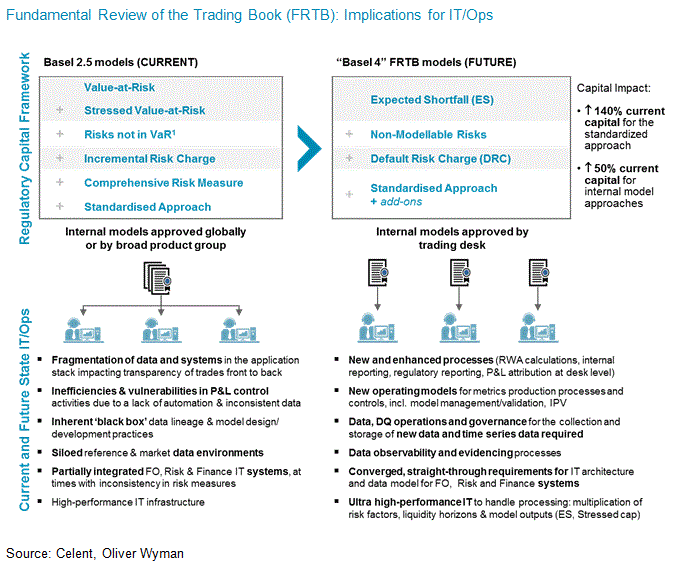FRTB and the Upcoming Renaissance in Market Risk Management, Part 1: How to Execute Sound Go-to-Market IT Strategies
Abstract
As firms execute implementation efforts in earnest for FRTB, Celent expects implementations to cost between $60 million and $150 million for a Tier 1 bank over the next three years. New requirements will drive firms to rejuvenate how their underlying risk IT architectures and data models, towards a renaissance in market risk management practices.

The Fundamental Review of the Trading Book (FRTB) represents the revised standards for minimum capital requirements for market risk, which follows from the previous revision of capital rules associated with Basel 2.5. With the end of 2019 deadline, FRTB is expected to be significant in terms of increases in capital, enhanced/granular risk measures, and more stringent modeling methodologies and stronger operational controls. In this report, FRTB and the Upcoming Renaissance in Market Risk Management (Part 1), Celent examines architectural archetypes, innovation possibilities, and the solution landscape for firms planning and executing to large-scale transformation initiatives.
Beyond current business and programme planning exercises, we expect the peak of IT investment and implementation efforts to occur through to early 2018, with the total implementation likely to cost between $60 million and $150 million for a Tier 1 bank over the next three years. New requirements will drive firms to re-examine how their underlying risk IT architectures and data model support high-performance requirements for generating new metrics, and to demonstrate robustness in data and model processes. Current siloed, fragmented, and black box approaches for risk management IT / operations will have to be significantly strengthened and enhanced.
“The imperative for architectural renewal or redesign is not a nice-to-have, especially if firms hold ambitions to achieve capital-light approaches for FRTB and to optimize capital on an ongoing basis,” says Cubillas Ding, Research Director with Celent’s Securities & Investments practice and author of the report. “Firms are planning to pursue different strategies, but we have observed forward-thinking firms take a deliberate and cohesive approach to formulating and more importantly, executing an explicit vision for their front office and risk IT in tandem,” Ding adds.

Based on Celent's experience, various strategic IT options and industry archetypes observed involve making decisions around boundaries of functionality between front office, risk, market data and product control, with considerations given to operational configurations around data centralization and ownership, governance of development lifecycle, controls, and levels of standardization. In many cases, firms will also be influenced by legacy constraints from existing investments, functional viability, and business units’ appetite for consolidating systems.
In the coming years, the journey to achieve compliance and mitigate the impact of additional capital under the new regime will require a fundamental change to the operating model between markets and trading businesses, with Risk and Finance functions. Siloed, black box, and loosely coordinated approaches that are typically used to underpin architectural foundations for front office, risk management, and finance operations will be increasingly costly to maintain and no longer be fit for purpose.
For firms planning and executing their implementation strategies, this report will highlight important IT considerations, architectural approaches, the landscape of solution vendors that are shaping the evolving FRTB ecosystem, and the coming renaissance of market risk management practices.
This 30-page report contains nine figures and one table.

